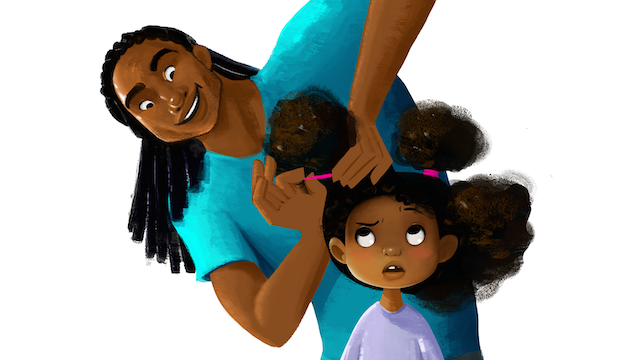I remember, a few winters back, driving by one of Atlanta’s few art house movie theaters and noticing a unique title on the board: “OSCAR NOMINATED SHORTS.”
Now THAT, I thought, is clever. Why not combine ten short films into one movie-going experience ?
Unfortunately I never followed through. These days, as a new parent, I see maybe one film a year in theaters and many more on my laptop in bed after my daughter falls asleep. But last week, when my sister in Manhattan called and raved about seeing this year’s crop of Oscar-nominated shorts, I was inspired.
At least, I was inspired to watch them on my laptop.
My wife and I rented the collection and were further delighted to find several shorts online for free – including the two that wound up winners. “The Neighbors’ Window” is a nimbly executed live-action film that fits extraordinary detail into a seemingly straightforward character piece. “Hair Love,” which won for animated short, left us in tears in less than seven minutes.
For those of us who work in journalism, there’s plenty to learn. Yes, we tell stories without staging, scripted lines from our subjects, and (typically) animation. But we still tell stories.
Here are five lessons from these two Academy Award winners as to how:
(SPOILER ALERT: I will be revealing key details about the plots of both films. My advice: watch each before you read further. They’re short, after all. And they’re worth the look.)
1. Embrace your limitations: “The Neighbors’ Window” is 20 minutes long, set and shot in two New York City apartments, and contains ten distinct scenes about a Brooklyn mother who realizes she can see into the apartment of the hard-partying twenty-somethings who move in across the street.
It was shot in four days. It cost less than $100,000.
Those numbers might seem astronomical for journalists, but they’re minimal for filmmakers. Yet Marshall Curry – who received honors as a documentarian before breaking into fiction – hustled hard and found ways to produce. He convinced the real-life apartment inhabitants to let him shoot for free; he convinced the actors of his vision; and he convinced himself he could cover everything he needed at a five-minute-per-day pace.
Every story in journalism comes with limits: the extra shot we can’t get, the drive we can’t make, the interview we can’t land. Don’t let those limits prevent you from persevering. Find creative – and compact – ways to get your viewers the information they need.
2. Don’t think you have your story figured out before you shoot it. Speaking of creative, Curry said his four-day schedule was almost derailed … by snow.
“On the second day of shooting, New York was hit by an unexpected blizzard,” Curry said on the podcast On the Mic with Tim Drake. They had planned to shoot half of a long scene on the day of the blizzard and half of it the next day. Since the main character’s apartment featured so many windows, Curry risked continuity issues where half the shots showed falling snow and half didn’t. “So that morning,” he said, “we decided to embrace the blizzard. We tweaked the script to include it. We shot all of the set-ups that faced a window the first day when the snow was coming down, and on the second day we shot all the reverse-angle shots where the window is behind the character.”
You’d never know from the final cut, which works seamlessly and sparkles because of the snow. The blizzard enhances the film, but only because Curry adjusted to incorporate it.
Too often we head out on an assignment with a preconceived notion of how it will unfold. That walls us off to the truth of a story – and the wrinkles that make it unique. In my experience, the most memorable moments are often the least expected, and a perceived snag in the shoot can become an essential component in a beautiful story.
3. Remember how good you’ve got it. This lesson comes from the film’s content, not its craft. In “The Neighbors’ Window,” the main character becomes jealous of and wistful for her neighbors’ seemingly carefree existence, but she ultimately learns it’s not so carefree – and that her neighbor similarly envies her through the window across the street.
It’s a great reminder for all of us in journalism, who cannot avoid social media and are continually bombarded with the highlights of our colleagues’ lives. We all possess unique skills and opportunities. Let’s celebrate our peers and appreciate our paths.
4. Set up your moments. “Hair Love” is a sweet, sweet six minutes. And in those six minutes, it delivers a multitude of moments. Some play for laughs, while some elicit tears and “Awwws.” All are richer because of how the filmmaker cultivates them.
Matthew E. Cherry crams so much life into the story of a father learning to do his daughter’s hair. But pay attention to how he does it. Here’s an early example: the film begins as the daughter awakens and jumps out of bed, beaming for the chance to style her hair. She throws on an outfit, pulls out her tablet, and scans an instruction-providing YouTube page until she arrives at the perfect look. When she finally finds it, the moment comes with a symphonic backing track, visions of the girl’s mother styling her hair, and dialogue spoken by Issa Rae. It’s glorious.
But it doesn’t happen without setup.
Beyond the daughter’s excitement, Cherry also builds up the payoff by showing her scan various hair options with her cartoon cat, who comically nixes each idea. You could point to dozens of directorial choices in the first 1:15 of the film that infuse the viewer with anticipation.
Journalists often forget this when producing stories for air. We scream our reveals at the top instead of laying the groundwork for them – or providing necessary context for them. “Hair Love” shows why setup needn’t be a sacrifice.
5. Represent your community. “Hair Love” also demonstrates an overdue lesson for storytellers of all stripes – and the gatekeepers in both Hollywood and newsrooms who decide which stories should be told. “We wanted to see more representation in animation,” Cherry said in his Oscar acceptance speech. “We wanted to normalize black hair.” He even brought to the ceremony DeAndre Arnold, a Texas teenager who became a news story when he was told his dreadlocks violated his high school’s dress code.
Arnold’s story grew because of journalists and news managers who decided it should be amplified. We make choices in every editorial meeting about what to cover – and what not to cover. It is our responsibility to fill our newsrooms with diverse voices, no matter our backgrounds, and then listen to those voices. The vast majority of us don’t make hiring decisions, but we can make conscious efforts to increase our exposure to media, communities, and individuals who bring different experiences and perspectives into our worlds.
The Solo Video Journalist is available for purchase. You can find it on Amazon, Barnes & Noble, and the publisher’s web site.
Matt Pearl is the author of the Telling the Story blog and podcast. Feel free to comment below or e-mail Matt at matt@tellingthestoryblog.com. You can also follow Matt on Facebook and Twitter.

